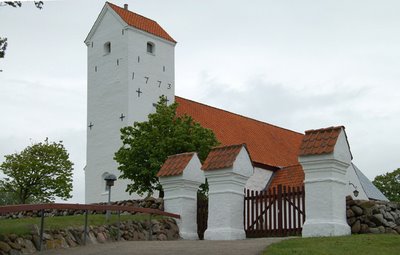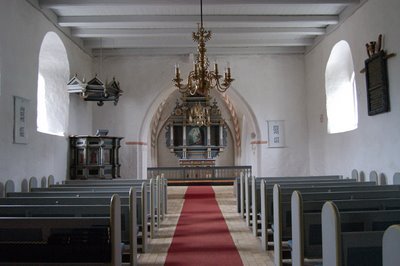
Helgenæs (Stødov) Church , ab. 15 km west of Ebeltoft
Helgenæs sogn, Mols herred, Randers amt.
Helgenæs Church is situated in Stødov on the peninsula of Helgenæs, the tip of 'Jutland's Nose' on the southern part of Mols and Djursland. Marsk Stig Andersen, the Jutland magnate, who resided on the island Hjelm opposite Helgenæs in his exile years after the murder of Erik V Clipping, had many fights with Erik VI Menved, and according to tradition he died on a field by Fejrup and was buried in Helgenæs Church, which however hasn't been proved. Another tradition says that he died upon his island Hjelm and that his men brought him to Stubberup Church on the island of Funen. A third tradition in a third church. A never-ending riddle.

Interior
The correct name is Helgenæs church, although people often name it Stødov Church. In ab.1186 the name was Helghænes. The church has Romanesque nave and choir , a Gothic tower and porch. It was restored in 1773 and 1957. The choir, nave and western addition are in raw and cleaved granite boulders with badly carved corner ashlars. Both straight-edged ashlar-built doors with inside planks are preserved. The three Romanesque building sections have contemporary oak-roofworks, the Romanesque beams of the choir were partly removed in the late Gothic period, when the room had a cross-vault; the pointed choir arch is probably contemporary. At the eastern wall of the choir was later built a supporting wall and three pillars. In the 1700s the church had a thorough repair and the tall arch of the tower was closed, while a new was broken towards the nave. The church was restored in 1957. It is now white-washed with tiled roofs and yellow brick floors. At the same time were brought to light simple frescoes in the choir, i.e. the coat of arms of the Århus bishop Jens Iversen Lange. In the church yard's western and eastern dike is a gate with Renaissance pillars. In a newer supporting wall at the foot of the hill are five iron binding-rings for horses.

Wedding frescoe Povel Oloffsen and Ellis Jonsdatter

Unicorn, one of the old frescoes found and restored in 1957.

Church ship,"Min Kones Minde" 1867
The inventory was restored in 1957. Communion table in raw granite boulder, covered in a Renaissance panel with arcades. Original paintings in the north and south-side's fields, flower-paintings in the three arcades. Altar piece in late Renaissance with four free-standing pillars in front of the big field, a rich top-field with a triangular gable. In the middle field a newer painting, in the top field an original painting and in the side fields biblical texts. Large beautiful Baroque candelabres upon three lions. Altar rails from 1800s across the choir. A Romanesque granite font with a smooth, almost cylindrical basin, the foot hidden in the floor. In the upper edge of the font a hole with rests of lead and iron. (for a lid). A south German baptismal bowl from ab. 1575. A pulpit in Renaissance with straight-edged fields with new-found paintings of the Evangelists. A new entrance, but a contemporary sounding board. Two neo-Gothic chandeliers. A church ship "Min Kones Minde" (Memory of my Wife): a threemaster full-rigged ship, made and given in 1867 by skipper and gårdejer (captain and farmer) Chr. Melchiorsen Svane. Bell from 1884. Epitaph in wood for Chr. Boserup. A memorial tablet 1920 for a soldier from the parish, who was killed at Dybbøl in 1864; a gravestone : Oluf Sørensen Dal ,rural dean, shot in 1628 by the imperial troups; two grave trees, one for Jon Persen Skriver + 1580, the other in the National Museum.

Kongsgård was under Kalø till 1661, when it was conveyed to Gunde Rosenkrantz. In 1721 Antoinette Rhode in Viborg owned 3/4 of K. ,which she in 1740 conveyed to herredsfoged Peder Høeg, who 1741 sold one of the farms to the priest at Helgenæs, Melchior Olufsen Sommerfeldt( + 1763), whose widow Mette Pauline Langballe in 1771 owned 2 farms in K. etc. After her death in 1801 her daughter's son N.L. Boserup, (later of Vinderup Ladegård) sold K. to captain Jacob Hanson. It then belonged to Søren Asch, but came in 1822 at auction to J.Scmidt's widow at Margrethelund, who the same year sold it to forvalter Ole J. Marcussen (+ 1835), whose widow married fuldmægtig U.C.S. Munck. He exchanged it in 1856 to C.B. Erhardi (+ 1879), whose widow Dorthea J. Secher then owned it. In 1902 it was bought by Søren Holst, in 1921 it was taken over by the son Aksel Holst, in 1960 by S.K.Holst.
The castle bank of Kongsgård is in the edge of a small, almost overgrown lake, it is a low circular islet, 23 m broad, surrounded by a moat towards land, brick-pieces have been found.
Across the land-tongue, which connects Helgenæs to the main-land is Dragsmuren which on both sides ends about 20 meter from the beach. It is a granite boulder dike, rather large stones, placed loosely above each other, it is 190 m long, 1,8 m broad and 1 m high. A priest-report to Ole Worm in 1623 says that the dike was built by Marsk Stig in order to demarcate Helgenæs which belonged to him. It is more likely an old royal game-hedge. During the first Schleswig-war the north side of the dike was covered in earth and to the south was built a fortificated section, which is still seen and was named Olaf Ryes Skanse, since he in 1849 sailed from here to Fredericia. Upon the highest point was in 1924 placed a memorial stone for Olaf Rye and for the Reunion. (see article about Dragsmur/Draget in my blog: Taste of Denmark in July 2009)
Helgenæs is often mentioned in history. Here was Harald Blåtand attacked by his son Sven Tveskæg with a fleet and forced to take flight, and Saxo says that it was here he was hit by Palnatoke's arrow, although Knytlingesaga places this event to Isefjorden (Sjælland). At Helgenæs Magnus den Gode's fleet defeated Sven Estridsen in 1044.
Helgenæs birk.(= judicial district) The peninsula is written as a king's estate in Valdemar Jordebog in 1231 and in the late Middle Ages most part of the estate was still under the Crown. Upon the peninsula was a special royal bailiff, 13/7 1523 a bailiff Jens Persen Bassy, who had confirmation of a life's letter (to have for life) which he had in the Kongsgården "i Hellnes", also named Helgenæsgård. Helgenæs birk is mentioned ca. 1525 when it was under Kalø vasalry. In 1686 is informed that the law/justice had not been administered more than 2 or 3 times a year. 17/12 1687 , according to open letter of 13/3 1688 the birk was placed together with Mols and Djurs Sønder herred.
A sacred well, Viekilde , was at the bay between Esby and Borup. There was also a sacred well at Ørby.
In Stødov was Hedegård (1575 Hiedgaard).
Names in the Middle Ages: Helgenæs (* ab. 1186 Helghænes); Stødov (1574 Storebye, 1594 Stødov); Fejrup (* 1360 Fæghædorp); Borup (* 1297 Bothorpmark); Ørby ( 1546 Mørby, 1610 Ørbye); Esby (1594 Esbye); Kongsgård (1476 Kongxgardh) .
Listed prehistorics: to small hills.
Demolished or destroyed: a dolmen chamber, two otter stone graves and 6 hills. - At Borup, around Vængesø, were found several kitchen middens, in one place a whale's head (skeleton) together with things from early Stone Age.
Source: Trap Danmark, Randers amt, 1963.
photo Helgenæs: grethe bachmann
1 comment:
https://olmstedcommunitychurch.org
Post a Comment